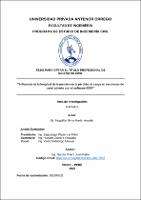| dc.contributor.advisor | García Rivera, Juan Pablo | |
| dc.contributor.author | Mogollón Nima, Martín Arcadio | |
| dc.creator | Mogollón Nima, Martín Arcadio | |
| dc.date.accessioned | 2022-11-10T14:14:53Z | |
| dc.date.available | 2022-11-10T14:14:53Z | |
| dc.date.issued | 2022 | |
| dc.identifier.uri | https://hdl.handle.net/20.500.12759/9680 | |
| dc.description.abstract | Esta investigación está enfocada en analizar las pérdidas de carga que se generan en los canales por efecto de transiciones para el cambio gradual de sección. En muchos casos el diseño de estas transiciones se hace enfocada en el espacio que se cuenta o viéndolas desde el punto de vista económico.
Para este análisis se ha calculado las pérdidas de acuerdo a la metodología recomendada por el USBR (United State Bureau Reclamation) y se ha contrastado con los resultados obtenidos en el modelamiento numérico bidimensional.
De acuerdo a la metodología del USBR el fondo de las transiciones tiene que seguir adaptarse al perfil de flujo y en el modelamiento se utilizó el fondo con la pendiente de los canales observándose que se presentan ondulaciones en la salida de la transición, incrementándose en secciones que van de rectangulares a trapezoidales. | es_PE |
| dc.description.abstract | This research is focused on analyzing the head losses that are generated in the channels due to the effect of transitions for the gradual change of section. In many cases, the design of these transitions is done focused on the space that is counted or seeing them from the economic point of view.
For this analysis, the losses have been calculated according to the methodology recommended by the USBR (United State Bureau Reclamation) and have been contrasted with the results obtained in the two-dimensional numerical modeling.
According to the USBR methodology, the bottom of the transitions must continue to adapt to the flow profile and in the modeling the bottom with the slope of the channels was used, observing that undulations appear at the exit of the transition, increasing in sections that They range from rectangular to trapezoidal. | en_US |
| dc.description.uri | Tesis | es_PE |
| dc.format | application/pdf | es_PE |
| dc.language.iso | spa | es_PE |
| dc.publisher | Universidad Privada Antenor Orrego | es_PE |
| dc.relation.ispartofseries | T_ING.CIVILP_030 | |
| dc.rights | info:eu-repo/semantics/openAccess | es_PE |
| dc.rights.uri | https://creativecommons.org/licenses/by/4.0/ | es_PE |
| dc.source | Universidad Privada Antenor Orrego | es_PE |
| dc.source | Repositorio Institucional - UPAO | es_PE |
| dc.subject | Hidráulica | es_PE |
| dc.subject | USBR (United State Bureau Reclamation) | es_PE |
| dc.subject | canales | es_PE |
| dc.title | Influencia de la longitud de transición en la pérdida de carga en secciones de canal abierto con el software IBER | es_PE |
| dc.type | info:eu-repo/semantics/bachelorThesis | es_PE |
| thesis.degree.level | Título Profesional | es_PE |
| thesis.degree.grantor | Universidad Privada Antenor Orrego. Facultad de Ingeniería | es_PE |
| thesis.degree.name | Ingeniero Civil | es_PE |
| thesis.degree.discipline | Ingeniería Civil | es_PE |
| dc.subject.ocde | https://purl.org/pe-repo/ocde/ford#2.01.00 | es_PE |
| renati.advisor.orcid | https://orcid.org/0000-0003-3498-7934 | es_PE |
| renati.author.dni | 72923171 | |
| renati.advisor.dni | 18216844 | |
| renati.type | https://purl.org/pe-repo/renati/type#tesis | es_PE |
| renati.level | https://purl.org/pe-repo/renati/level#tituloProfesional | es_PE |
| renati.discipline | 732016 | es_PE |
| renati.juror | Sagastegui Plasencia, Fidel | |
| renati.juror | Hurtado Zamora, Oswaldo | |
| renati.juror | Vertiz Malabrigo, Manuel | |
| dc.publisher.country | PE | es_PE |


